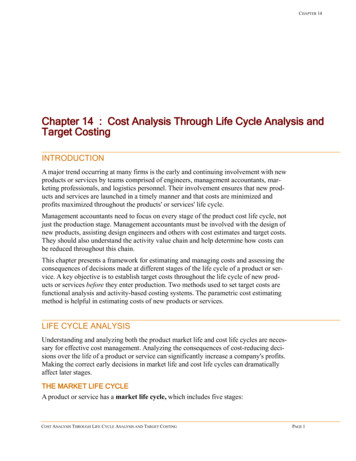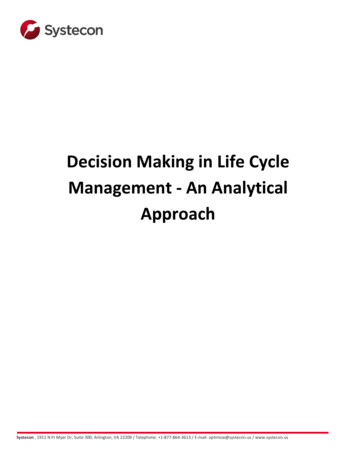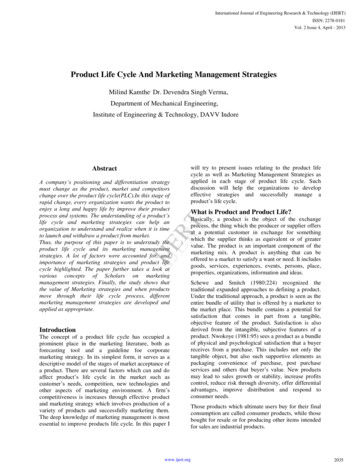
Transcription
IMPORTANT OF LIFE CYCLE COST ON BUILDING PROJECTS1AYEDH ALQAHTANI, 2ANDREW WHYTE1,2Department of civil engineering, Curtin UniversityE-mail: 1a.alhajiri@hotmail.com, 2Andrew.whyte@curtin.edu.auAbstract- this paper clarifies the important of life cycle cost on building projects and explains the effect ofaccuracy estimate of the total life cycle cost on building projects. In addition, this paper aims to provide generalconcepts about the field of life-cycle costing. The purpose is to provide the essential backgrounds which will assistthe stakeholders to understand the benefits of implementation of life cycle cost in the building projects.Keywords- Life cycle cost, Building projects, estimation and accuracy.I. INTRODUCTIONinvolves cost reporting, accurate cost classificationand calculation of profit. Akintoye and Fitzgerald [7]surveyed 84 building companies in UK and found thatcost estimation is a key method for constructioncontractors in terms of construction planning purposesrather than construction evaluation. Several surveyshave been conducted by Hegazy and Moselhi [8] toidentify the main elements of cost estimation and thekinds of methods used for estimation of these elementsby building construction constructors in Canada andthe USA; they found that the majority of contractorsestimated direct and project overhead costs in adetailed manner. Assaf [9] studied the overhead costof construction project in Saudi Arabia and found thatthe decision about the optimum level of overhead costsis difficult for construction companies to make it dueto unstable construction market which enables them towin and carry out large projects.There are numerous ways to define the concept of cost.Generally, cost is the financial value of all goods andservices consumed in order to achieve anorganisation’s goals [1]. Cost estimating is one of themost crucial functions in decision making at the earlyphase of a project life-cycle [2]. All decisions aboutcost estimating and the implications for the project athand, requires a range of stakeholders including theowner, contractor, designer, and lending company,involving economic analysis of number of alternativeproject components, clarifying the feasibility of aproject or identifying an initial cost of a project [3].The next section identifies the importance of costestimation for construction projects.II. IMPORTANT OF COST ESTIMATION ONCONSTRUCTION PROJECTSAibinu and Pasco [10] studied the importance andaccuracy of cost estimation of building constructionprojects in Australia. Their study involved examining56 building construction projects and surveying 102companies. Their results indicate that size of project isthe most influential factor in cost estimation ofbuilding construction project in Australia.Overestimated cost by a large amount often occurredin small projects rather than under-estimations. Inorder to improve cost estimation, they recommendedseveral methods such as using probability estimationand simulation of past estimates; such methods arediscussed further below.Estimation is an important financial issue to be takeninto account as part of the project managementexercise. It involves estimation of total costs andbenefits of the project and alternatives. The projectmanagement team subsequently measures the returnon investment or the payback period (the period oftime that project will take to recoup the initial costinvested on project) to make an assessment about thedesirability of the chosen alternative. This informationalso helps in shaping the opinion of financial andbanking institutions that are associated with theproject.The significance and influence of construction costestimating is supported by research. Carr [4], forexample, has contended that cost estimation deliverssubstantial information for cost planning, resourcecontrolling and decision making. Cost estimation isone of the most important factors to the success ofproject [5]. Alcabes [6] articulated that cost estimatorsduties include preparation of all estimates, check listsand pricing information; he also asserts that costestimation is the heart of construction work as itIII. THE EFFECT OF INACCURATE COSTESTIMATION ON CONSTRUCTIONPROJECTSAccurate cast estimation is a challenging task in theconstruction project, in which cost estimation is thedetermination of the total project cost and preparedbased on limited information and under situations ofhigh uncertainty [11]. There are three possible resultsProceedings of 21st TheIIER International Conference, Australia, 11th April 2015, ISBN: 978-93-82702-92-422
Important Of Life Cycle Cost On Building Projectsof cost estimation which are: accurate estimateoverestimates and underestimate.The relationships between these outcomes can be seenin the fig.1. This figure has been represented by FrankFreiman who developed fast cost estimation systemfor Radio Corporation of America (RCA).Overestimates may lead to higher cost out-run thanprojected due to under-utilisation of resources such asstaff, acquiring excess capacity and the companybecoming weak because it is unable to provide asuitable product for a reasonable price.On the other hand, a cost under-estimate means thetotal cost of project is more than predicted. Poorestimation and planning are often the causes ofunder-estimate. The outcome of an under-estimatedproject may lead to increasing the cost of projects dueto reorganisation and replanning resulting in delay[12]. In this case, Construction client has threeoptions[13]:1. A construction client will terminate the project andincur loss.2. A construction client will carry out the project whileseeking extra funding.3. A construction client will decrease the quality of theproject to avoid the additional funding.Good cost estimation requiring realistic estimates andeconomical project cost-ings help achieve a project’sgoals as illustrated by [12] in fig.1 below. Themethods to assist in this activity are discussed in thefollowing section.method was its simplicity [14]. Furthermore,construction clients always give a high priority toinitial cost as the most visible one. They are unable toaware the inter-dependant relation between life cyclecost of the construction and the initial constructioncost [15]. Previous studies indicate that often the totalcost of ownership of engineering system exceed initialcosts. According to several studies, the total cost ofownership of engineering system (i.e., maintenanceand running cost) is about 10 to 100 times the originalinitial costs [14]. In civil engineering sector, the initialcost of building project represents only a small amountof its life cycle cost. It has been predicted that theinitial cost of building projects is about five times lessthan their life cycle cost [16]. For example, NationalBuilding Research Institute of South Africa reportedthat the initial cost of hospital building is only between6 to 10 % of the total life cycle cost. In addition, theyfound that from 2 to 3 years after the projectconstruction completing, the operation costs exceedthe initial cost[17]. Moreover, Roger, George, Justinand Graham [18] studied the life cycle cost of differenttypes of building such as Primary schools, home forelderly and Secondary schools and indicated that theinitial cost of these projects is less than half of the totallife cycle cost as in fig. 2-4. The same result has beenfound by O'Rourke [19] in UK as in fig. 5.Fig.2 Life cycle cost for homes for elderlyFig. 1 the Freiman CurveThe next section illustrate the impact of makingdecision about the project based on capital costsinstead of consider all total cost including capitalcosts, maintenance and operation and disposal cost.IV. THE IMPORTANT OF TAKING INTOACCOUNT ALL TOTAL COST INSTEAD OFTHE INITIAL COSTIn the past, decisions in the construction of many civilengineering systems and buildings throughout thedesign phase were made basically by comparing initialcapital costs. The main motivation for utilising thisFig. 3 Life cycle cost for Primary schoolProceedings of 21st TheIIER International Conference, Australia, 11th April 2015, ISBN: 978-93-82702-92-423
Important Of Life Cycle Cost On Building ProjectsThe utilizing of life cycle cost approach may lead toincrease the initial cost of building but in same timemay decrease the amount of the overall cost over thelife of this project. The purpose of life cycle costapproach is to inject the maximum information intothe design phase, assisting to decrease waste and toimprove efficiency of design and construction as wellas operation and maintenance [16].V. HISTORY AND DEFINITIONS OF LIFECYCLE COSTThe principle of Life –cycle Costing (LLC) is not new.The first extension of life cycle cost dates back toWorld War II when the U.S Department of Defence(DOF) used life cycle cost in the procurement ofweapons and weapon support system[22].In the early 1960s, the life cycle cost theory wasdeveloped by the DoD to increase the effectiveness oftheir procurement policies [23]. These policies werediscussed by several researchers in the followingreferences- Metzler[24], Gansler [25], Earles [26],Dixon & Anderson [ 2 7 ] , Caver [ 2 8 ] andDighton[29].The Japanese is considered the first country usedlife cycle cost concepts widely to overcome thedestruction of World War II, and to refresh theireconomy as the second objective by saving costs inthe long term [30]. In the 1970s idea of integrateproduct design and economic modelling wasnarrowly applied. In the late 1970s, the life cyclecost was employed on construction projects in U.Swith aim to discover the alternative energy designchoices in construction projects [31].Prior to the 1970, the procurement decisions weremaking based only on capital costs. During thattime, Terotechonology School discussed that therewere alternative and more effectiveness methods ofmaking decisions than based only on capital costs[32]. The life cycle cost idea was widely beginningby the argument of spending more in initial costwould consequence in saving more in the long termwhen compared with cheaper options. While theconcept of life cycle cost are created on , engineering and risk analysis,implementation of life cycle cost in constructionengineering sector is still under improvement [ 3 3 ] .The main aim of any construction engineering activityhas always to analyze and determine how they candesign and arrange physical factors in order to createbeneficial in a way that meets the need at the lowestpossible cost. Therefore, a principle of life cycle costwas always included in engineering designs.It was often thought that it can achieve economiccompetitiveness and strengthened through a life-cycleattitude in engineering. Although this philosophydeeply rooted engineering economic has beenFig.4 Life cycle cost for secondary schoolFig. 5 Life cycle cost for National schoolIn order to successfully complete projects and makeprofit, the acquisition decisions of constructionprojects at the design stage should be made based ontheir life cycle costs rather on their initial costs. Inaddition, appropriate cost reduction measures can beeasily taken when predict of the life cycle cost isavailable at an early design phase. However, when theconstruction project moves from early design stage toconstruction stage, possibilities to influence the totalconstruction project cost are decreased quitesignificantly [20]. Fig. 6, shows that the ability todecrease cost of project during all stage of project’slife cycle[21].Fig. 6 the ability of decrease cost of project during all stageProceedings of 21st TheIIER International Conference, Australia, 11th April 2015, ISBN: 978-93-82702-92-424
Important Of Life Cycle Cost On Building Projectsconfirmed by engineers at early stage of the project’slife cycle, and focus primarily on the performance ofearly design with ignored generally the project lifecycle performance, financial factors and consequencesof operational and maintenance phases at the laterphases of the project life-cycle [34].The term cost-in-use refers to as operation costs ofprojects and was appeared in the literature in the early1970s. However, The main weakness of this termmodel was its incapability to predict future costs [32].Recognizing that prediction was a key element, theconcept of the LLC appeared as a new methodologyfor assessing the costs through the late 1970s. Theutilisation of life cycle cost in UK construction sectorreceived a motivation with the publication by theRoyal Institute of Chartered Surveyors of study byFlangan [35] on the concept and implementation oflife cycle cost. In addition, the society of ChiefSurveyors in Local government provided a report inthe form of practice manual. Ashowrth[36] has triedto focus more on the reasons behind the difficulties inapplication of life cycle cost.Internationally, the application of life cycle cost hasbeen gaining consideration. In 1985 there wasconference held in New Zealand concerning about theimpacts of decision making at early stages of asset'slife cycle on the value of building assets. There wasgeneral agreement on the principle of total life cyclecost's importance; but no proof was existed of itsnormal employ as management tool by designers andproject owners in New Zealand[37].According to Ashworth [36] the life cycle cost hasbeen widely applied in North America asrecommended by Jelen and Black's [38], Ahuja andWalsh[39], and Lawl. Ruegg [37]carried out survey inU.S. and found that eight organisations had 14 lifecycle cost documents guiding internal life cycle costpractise. Four documents were represented toinvestment in general, seven to energy investment,two to renovation decision and one to investment inhospitals.Moreover, The Department of Energy has taken planto expand the utilization of life cycle cost. The purposeof this program was to present practical and effectiveways and process to Federal agencies for predictionlife –cycle cost; to present saving of proposed andrenewable energy [37].In light of the above definitions, life cycle cost can bethought as a systematic assessment of total cost ofasset from cradle to grave. It is a structured techniquewhich assists in analysis alternatives, and therefore inreducing total expenditure over its anticipatedlife-span. This technique can be used from thesimplest to the most complex projects. For example,when purchasing a new house, several factors may beconsidered such as maintenance, original cost,insurance, mortgage liability and so forth. This is anexample of the life cycle cost principle. The outcomeof life cycle cost can be utilized to aid management inthe decision making procedure when there isalternative option.VI. THE OBJECTIVE OF LIFE CYCLE COSTInvestment in the industry involves several ofdecisions for difference purposes. Some of thesedecisions are about budget and cost, some aboutbenefits, some have immediate effect, and some havelong term impact. Using life cycle cost as tools ofmaking decision can be useful for shareholders ofproject (Client, Project team and contractor). Theclient may use life cycle cost to evaluate projectviability, make a correct decision about the project(continuing or aborting a project), analysis all costsbudget which are required for carry out the project andto measure the capability of pay for design facility.The project teams may use life cycle cost to choosebest alternative among options and the most usefulprocurement approach, identify cost drivers andpredict future budget requirements, create significantdecisions policy and design trade-offs, controlprogrammes and minimise total cost and clarify issueslinked to the ultimate disposal of the asset. life cyclecost can be used to select contractor when the projectis placed for tender. In addition, there are manynumber of recent trends have appeared as issue ofworry for the design professional, involving:environmental sustainable, total quality management,value engineering, operation effectiveness, facilityobsolescence. life cycle cost can be utilized to dealwith these issues.CONCLUSIONThis paper illustrates the importance of constructionprojects, and estimation cost. There is generallyagreement that construction projects must change theold method of investment which concern about initialcost with the concept of life cycle cost method whichconcern about all cost occurred during all stages ofasset life cycle.This paper also clarifies the historical development ofthe concept of life cycle cost from its early utilize inthe military purposes to a broader approach. Life cyclecost is a systematic assessment of total cost of assetfrom cradle to grave. It can be used to estimate thetotal cost of an asset from early stage to disposal stage.In light of above one may conclude that life cyclecosting can be utilized as management tool to supportdecision making process that may be incurred duringall phases of construction project’s life cycle (moredetails about construction project life cycle stages willbe discussed in next chapter). Many researchersbelieve that making decision at early stage ofconstruction project life cycle have the most importantProceedings of 21st TheIIER International Conference, Australia, 11th April 2015, ISBN: 978-93-82702-92-425
Important Of Life Cycle Cost On Building Projectseffects on the running costs of construction projectover their life [11][12][13][14][15][16][17][18][19][20][22]Yaman, H. and E. Tas, ‘’A building cost estimation modelbased on functional elements. A,’’ Z ITU Journal of Faculty ofArchitecture, vol. 4, p. 73-87, June 2007Murat Günaydın, H. and S. Zeynep Doğan, “A neural networkapproach for early cost estimation of structural systems ofbuildings”. International Journal of Project Management, vol.22, p. 595-602, May 2004Sonmez, R., “Conceptual cost estimation of building projectswith regression analysis and neural networks”. CanadianJournal of Civil Engineering, vol. 31, p. 677-683, April 2004.Carr, R., “Cost‐Estimating Principles. Journal of ConstructionEngineering and Management”, vol.115, p. 545-551, July1989.Dysert, L. and B.G. Elliott, “The Estimate Review andValidation Process. Cost Engineering,” vol. 44, p. 17,November 2002Alcabes, J., “Organizational concept for a coordinatedestimating, cost control, and scheduling division”. AACE,October 1988.Akintoye, A. and E. Fitzgerald, “A survey of current costestimating practices in the UK”. Construction Managementand Economics, vol. 18, p. 161-172, May 2000.Hegazy, T. and O. Moselhi, “Elements of cost estimation: Asurvey in Canada and the United States”. Cost Engineering,vol. 37, p. 27-27, Jan 1995.Assaf, S.A., et al., “The management of construction companyoverhead costs”. International Journal of Project Management,vol. 19, p. 295-303, June 2001.Aibinu, A.A. and T. Pasco, “The accuracy of pre-tenderbuilding cost estimates in Australia”. ConstructionManagement & Economics, vol. 26, p. 1257-1269, March2008.Flood, I., “Modeling Uncertainty in Cost Estimates: AUniversal Extension of the Central Limit Theorem”. p.551-558. April 1997.Daschbach, J.M. and H. Apgar, “Design analysis throughtechniques of parametric cost estimation”. Engineering Costsand Production Economics, vol. 14, p. 87-93, May 1988.Peter, M.L. and J.E. Peter, “Design cost Modelling - A wayforward COST”. The Australian Journal of ConstructionEconomics & Building, vol.1 pp. 1-7, March 2001.Dhillon, B., “Life Cycle Costing for Engineers. first ed”.United States of America: CRC Press 196, May 2009Barrett, P. and C. “Stanley, Better construction briefing”. UK:Blackwell Science, April 1999.Evans, R., et al., “The Long Term Costs of Owing and UsingBuildings”. The Royal Academy of Engineering: London.Feb. 1998Bull, J.W., “Life Cycle Costing For Construction”. 1st ed.London: Blackie Academic & Professional 159, May 1992.Roger, F., et al., “Life cycle costing : theory and practice”.London: Blackwell Science Inc, Jule 1989.O'Rourke, C., “Cost in Use”. The Engineers Journal, vol.1, p.15-20, October 1984.Khanduri, A., C. Bedard, and S. Alkass, “Life cycle costing ofoffice buildings at the preliminary design stage”, inProceedings of the 5th International Conference on Civil ][35][36][37][38][39]Structural Engineering Computing., Civil-Comp Press:Edinburgh. p. 1-8, April 1993.KDell'Isola, J. and J. Kirk, “Life cycle costing for designprofessionals” . New York: McGraw-Hill, May 1981.Kabbani, I.A., “Decision Support Life-cycle Analysis Systemin Building Design”, University of Colorado at Boulder:Colorado. p. 548, November 1993.Shields, M.D. and S.M. Young, “Managing product life cyclecosts: An organizational model”. Cost Management , p. 39-52,Jule 1991.Metzler, E.G.” Forcing functions integrate R&M into design(DOD TACAN procurement policy on reliability andmaintainability)”. in PROCEEDINGS ANNUAL R&MSYMP. Los Angeles: New York, Institute of Electrical andElectronics Engineers, Inc. June 1979.GANSLER, J.S. “APPLICATION OF LIFE CYCLECOSTING TO THE DOD SYSTEM ACQUISITIONDECISION PROCESS”. in PROCEEDINGS ANNUALR&M SYMP. Los Angeles: New York, Institute of Electricaland Electronics Engineers, Inc. July 1979Earles, D.R. “Design to Operation and Supports Costs”. inPROCEEDINGS ANNUAL R&M SYMP. Los Angeles: NewYork, Institute of Electrical and Electronics Engineers, Inc.May 1974DIXON, T.E. and R.H. ANDERSON. “IMPLEMENTATIONOF THE DESIGN TO COST CONCEPT. in PROCEEDINGSANNUAL R&M SYMP”. Los Angeles: New York, Instituteof Electrical and Electronics Engineers, Inc. October 1976.Caver, T.V., “Life Cycle Cost: Attitude and Latitudes”.Defense Management Journal, vol.14 , p. 12-17, April 1979.Dighton, R.D. “The Hornet program: A design to life cyclecost case study”. in Proceedongs of the Design to Cost andLife-cycle Cost AGARD Confrence. May 1980.Emblemsvag, J., “Life-cycle Costing: Using Activity-basedCosting and Monte Carlo Methods to Manage Future Costsand Risk”. New Jersey: John Wiley & Sons. June 2003Raymond, J.C. and S. Eva, “Reconciling theory and practice oflife-cycle costing”. Building Research and Information, vol.28. p. 368-375, April 2000.Boussabaine, H.A. and R.J. Kirkham, “Whole life-cyclecosting : risk and risk responses”. Malden: BlackwellPublishing. May 2007.Pelzeter, A., Building optimisation with life cycle costs - theinfluence of calculation methods. Journal of FacilitiesManagement, vol. 5, p. 115-128, March 2007Fabrycky, W.J. and B.S. Blanchard, “Life-cycle cost andeconomic analysis”. Prentice Hall, June 1991.Flanagan, R., Life cycle costing for construction / prepared byRoger Flanagan, George Norman with J. David Furbur, ed. G.Norman, J.D. Furbur, and S. Royal Institution of Chartered.London: London : Published on behalf of the Royal Institutionof Chartered Surveyors by Surveyors Publications. June 1983.Ashworth, A., Life-Cycle Costing: A Practice Tool? CostEngineering, vol. 31, p. 8-8, May 1989.Al-Hajj, A., “Simple Cost-significant Models for TotalLife-cycle Costing in Buildings”. University of Dundee.December 1991.Jelen, F.C., J.H. Black, and A.A.o.C. “Engineers, Cost andoptimization engineering”. McGraw-Hill, May 1983Ahuja, H.N. and M.A. Walsh, “Successful methods in costengineering”. Wiley, May 1983 Proceedings of 21st TheIIER International Conference, Australia, 11th April 2015, ISBN: 978-93-82702-92-426
Important Of Life Cycle Cost On Building Projects Proceedings of 21st TheIIER International Conference, Australia, 11th April 2015, ISBN: 978-93-82702-92-4 24 Fig.4 Life cycle cost for secondary school Fig. 5 Life cycle cost for National school economy as the second objective by saving costs in In order to successfully complete projects and make










